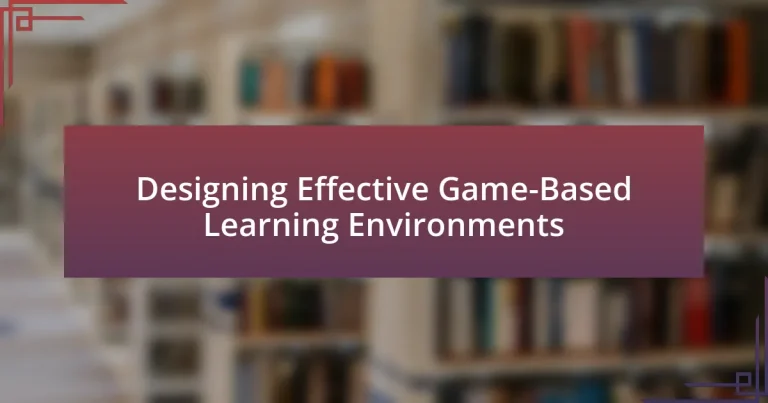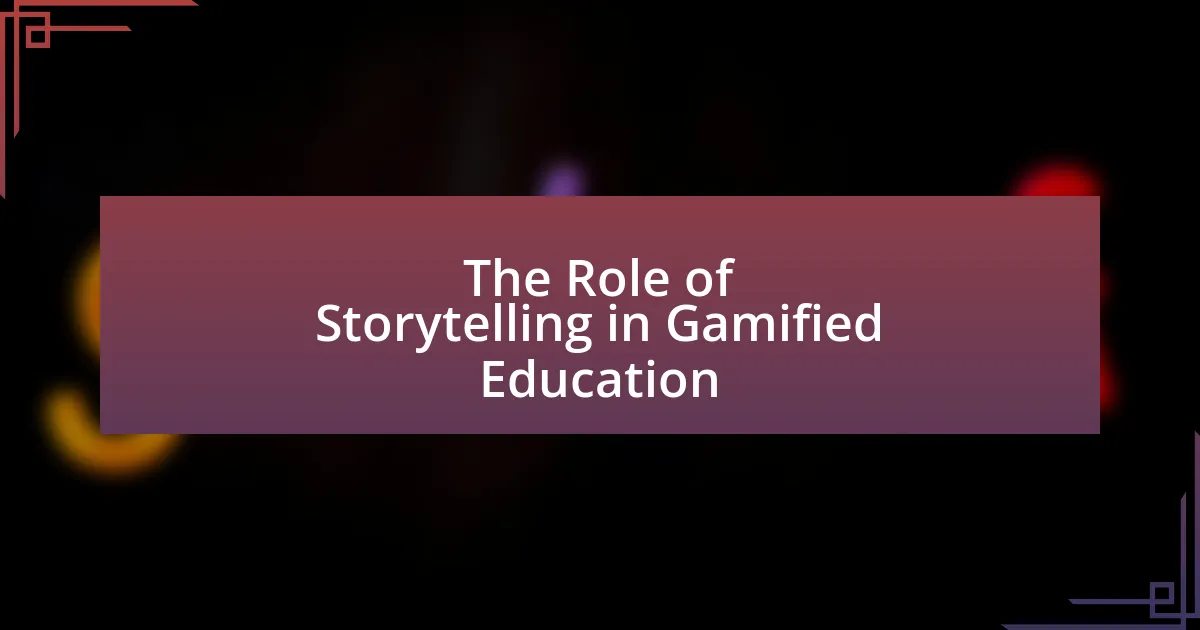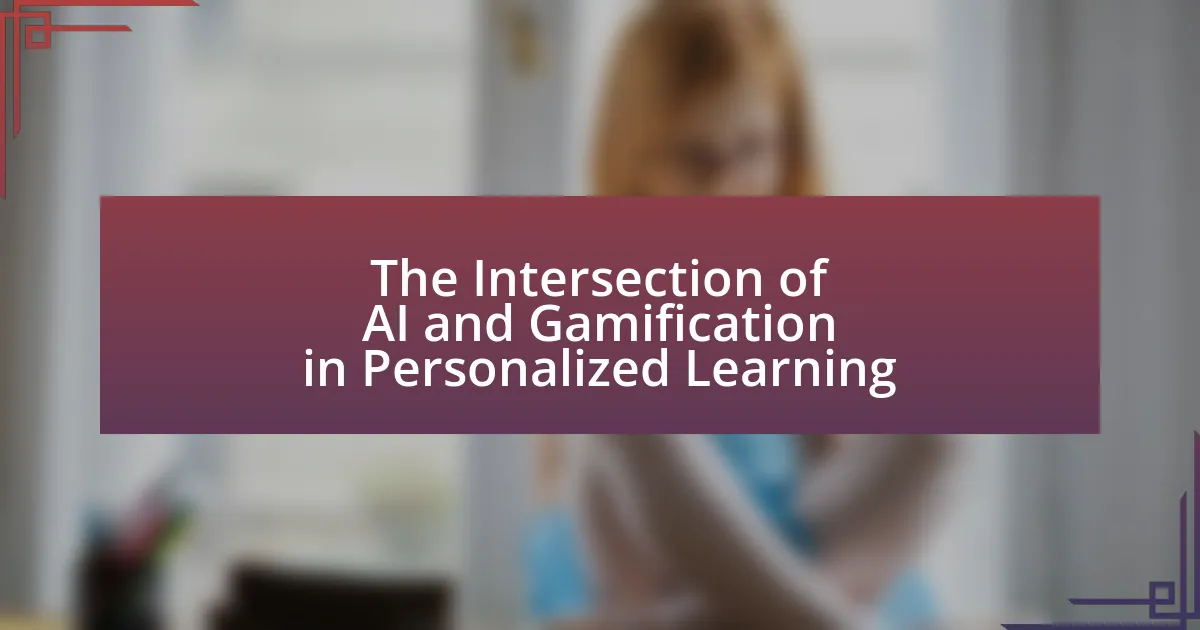Game-Based Learning Environments are interactive educational settings that utilize game mechanics to enhance learner engagement, motivation, and knowledge retention. This article explores the differences between game-based and traditional learning methods, highlighting key elements such as engagement, feedback, and adaptability that define effective game-based environments. It also discusses the importance of motivation and collaboration, strategies for integrating game-based learning into curricula, and the tools and technologies that support these environments. Additionally, the article addresses potential challenges and misconceptions surrounding game-based learning, providing best practices for educators to ensure inclusivity and effectiveness in their designs.

What are Game-Based Learning Environments?
Game-Based Learning Environments are interactive settings where educational content is delivered through game mechanics and principles. These environments engage learners by incorporating elements such as challenges, rewards, and competition, which enhance motivation and retention of knowledge. Research indicates that game-based learning can improve student engagement and achievement; for instance, a study by Hamari et al. (2016) found that gamification positively influences learning outcomes in educational contexts.
How do Game-Based Learning Environments differ from traditional learning methods?
Game-Based Learning Environments differ from traditional learning methods primarily in their interactive and immersive nature, which enhances engagement and motivation among learners. Traditional methods often rely on passive learning techniques, such as lectures and rote memorization, whereas game-based environments promote active participation through challenges, rewards, and immediate feedback. Research indicates that students in game-based settings demonstrate higher retention rates and improved problem-solving skills, as evidenced by a study published in the Journal of Educational Psychology, which found that game-based learning can increase student achievement by up to 20% compared to conventional approaches.
What key elements define Game-Based Learning Environments?
Game-Based Learning Environments are defined by key elements such as engagement, interactivity, feedback, and educational objectives. Engagement is crucial as it motivates learners to participate actively in the learning process, while interactivity allows learners to explore and manipulate game elements, enhancing their understanding. Feedback provides immediate responses to learners’ actions, facilitating improvement and reinforcing learning. Educational objectives ensure that the game aligns with learning goals, making the experience purposeful. These elements collectively create an immersive and effective learning experience, supported by research indicating that game-based learning can improve retention and understanding of complex concepts.
Why is engagement important in Game-Based Learning Environments?
Engagement is crucial in Game-Based Learning Environments because it directly influences motivation, retention, and the overall effectiveness of the learning experience. When learners are engaged, they are more likely to immerse themselves in the content, leading to deeper understanding and retention of knowledge. Research indicates that high levels of engagement can enhance cognitive processes, making it easier for learners to apply concepts in real-world scenarios. For instance, a study by Hamari et al. (2016) found that engagement in gamified learning environments significantly improved student performance and satisfaction. Thus, fostering engagement is essential for maximizing the educational benefits of game-based learning.
What are the core principles of designing effective Game-Based Learning Environments?
The core principles of designing effective Game-Based Learning Environments include engagement, clear learning objectives, feedback mechanisms, and adaptability. Engagement is crucial as it motivates learners to participate actively; studies show that games can increase motivation by up to 50%. Clear learning objectives guide players on what they are expected to learn, ensuring that educational goals are met. Feedback mechanisms provide players with immediate responses to their actions, which enhances learning retention; research indicates that timely feedback can improve performance by 20%. Lastly, adaptability allows the game to cater to different learning styles and paces, making it more inclusive; evidence suggests that personalized learning experiences can lead to a 30% increase in learner satisfaction.
How does motivation influence the design of Game-Based Learning Environments?
Motivation significantly influences the design of Game-Based Learning Environments by determining how engaging and effective the learning experience will be. Designers incorporate elements such as rewards, challenges, and narrative to enhance intrinsic motivation, which has been shown to improve learning outcomes. For instance, research by Deci and Ryan (2000) on Self-Determination Theory highlights that environments fostering autonomy, competence, and relatedness lead to higher motivation levels. This indicates that when game-based learning environments are designed with motivational factors in mind, they can better facilitate student engagement and knowledge retention.
What role does feedback play in enhancing learning outcomes?
Feedback plays a crucial role in enhancing learning outcomes by providing learners with specific information about their performance, which helps them identify areas for improvement. Research indicates that timely and constructive feedback can significantly increase student engagement and motivation, leading to better retention of knowledge and skills. For instance, a study published in the “Journal of Educational Psychology” by Hattie and Timperley (2007) found that feedback is one of the most powerful influences on learning, with effect sizes indicating substantial improvements in student achievement when feedback is effectively utilized. This evidence underscores the importance of integrating feedback mechanisms in game-based learning environments to optimize educational experiences.
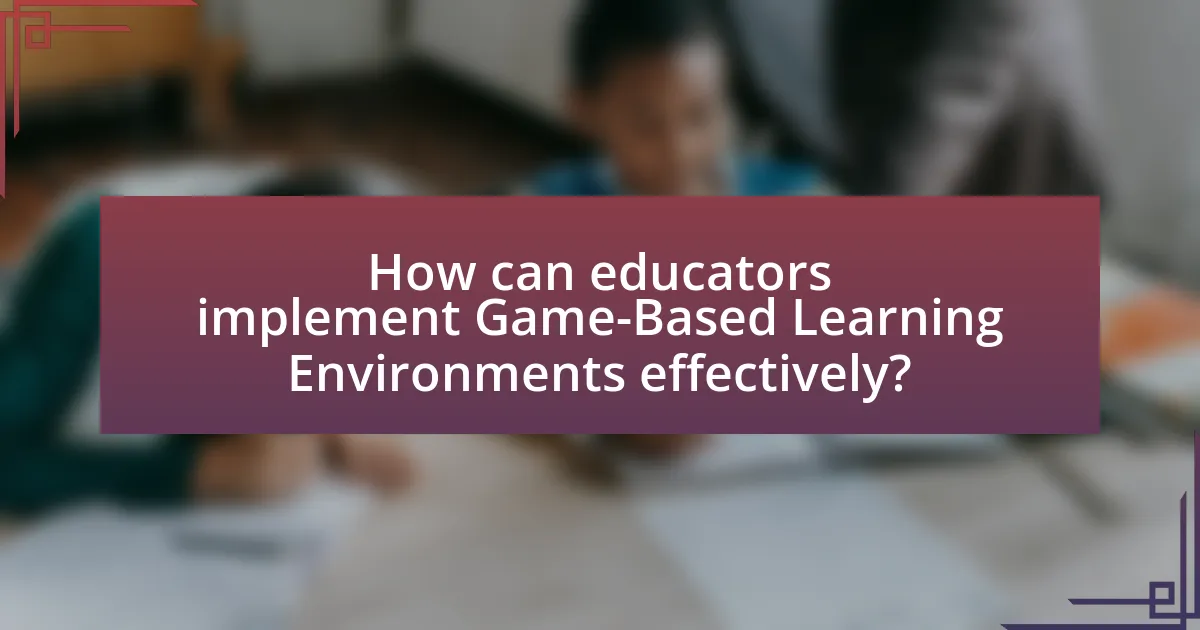
How can educators implement Game-Based Learning Environments effectively?
Educators can implement Game-Based Learning Environments effectively by integrating educational objectives with engaging game mechanics. This approach ensures that the learning experience is both enjoyable and aligned with curriculum goals. Research indicates that when game elements such as rewards, challenges, and narratives are incorporated into lessons, student motivation and retention improve significantly. For instance, a study by Hamari et al. (2016) published in “Computers in Human Behavior” found that gamification in educational settings enhances student engagement and learning outcomes. By designing activities that promote collaboration, critical thinking, and problem-solving within a game context, educators can create a dynamic learning environment that fosters deeper understanding and skill development.
What strategies can be used to integrate Game-Based Learning into the curriculum?
To integrate Game-Based Learning into the curriculum, educators can employ strategies such as aligning game objectives with learning outcomes, utilizing existing educational games, and incorporating game mechanics into traditional lessons. Aligning game objectives ensures that the skills and knowledge students gain through gameplay directly support curriculum goals, enhancing relevance and engagement. Utilizing existing educational games allows teachers to leverage proven resources, saving time and effort in game development while providing students with quality content. Incorporating game mechanics, such as points, levels, and rewards, into traditional lessons can motivate students and create a more interactive learning environment, as evidenced by studies showing increased student engagement and achievement when game elements are present in educational settings.
How can educators assess the effectiveness of Game-Based Learning?
Educators can assess the effectiveness of Game-Based Learning by utilizing a combination of formative and summative assessments, along with qualitative feedback from students. Formative assessments, such as quizzes and in-game performance metrics, provide immediate insights into student understanding and engagement levels. Summative assessments, including standardized tests or project-based evaluations, measure overall learning outcomes after the game-based intervention. Additionally, qualitative feedback through surveys or interviews can reveal students’ perceptions and experiences, offering a comprehensive view of the learning impact. Research indicates that integrating these assessment methods can lead to a more accurate evaluation of educational effectiveness, as demonstrated in studies like “The Impact of Game-Based Learning on Student Engagement and Learning Outcomes” published in the Journal of Educational Technology.
What challenges might educators face when implementing Game-Based Learning?
Educators may face several challenges when implementing Game-Based Learning, including a lack of resources, insufficient training, and resistance from students or parents. Limited access to technology can hinder the integration of game-based methods, as many educational institutions may not have the necessary hardware or software. Additionally, educators often require specialized training to effectively design and facilitate game-based learning experiences, which may not be readily available. Resistance from students or parents can arise due to misconceptions about the educational value of games, leading to a lack of support for these initiatives. These challenges can impede the successful adoption of Game-Based Learning in educational settings.
What tools and technologies support Game-Based Learning?
Game-Based Learning is supported by various tools and technologies, including game development platforms, learning management systems, and simulation software. Game development platforms like Unity and Unreal Engine enable educators to create interactive learning experiences tailored to specific educational goals. Learning management systems such as Moodle and Blackboard integrate game elements to enhance student engagement and track progress. Additionally, simulation software like Labster provides immersive environments for practical learning in fields such as science and engineering. These tools facilitate the design and implementation of effective game-based learning environments by promoting active participation and enhancing knowledge retention.
Which platforms are most effective for creating Game-Based Learning experiences?
The most effective platforms for creating Game-Based Learning experiences include Kahoot!, Classcraft, and Minecraft: Education Edition. Kahoot! allows educators to create interactive quizzes and games that engage students in a competitive format, enhancing learning through fun. Classcraft gamifies the classroom experience by incorporating role-playing elements, encouraging collaboration and motivation among students. Minecraft: Education Edition provides a sandbox environment where learners can explore, create, and collaborate on projects, fostering creativity and problem-solving skills. These platforms have been widely adopted in educational settings, demonstrating their effectiveness in enhancing student engagement and learning outcomes.
How can technology enhance interactivity in Game-Based Learning?
Technology enhances interactivity in Game-Based Learning by providing immersive experiences that engage learners through real-time feedback, adaptive learning paths, and collaborative features. For instance, platforms like Kahoot! and Quizlet utilize technology to create interactive quizzes and games that allow students to compete and collaborate, fostering a dynamic learning environment. Research indicates that interactive elements, such as instant feedback and peer interaction, significantly improve student motivation and retention rates, as evidenced by a study published in the Journal of Educational Psychology, which found that students who engaged in interactive learning scored 20% higher on assessments compared to those in traditional settings.
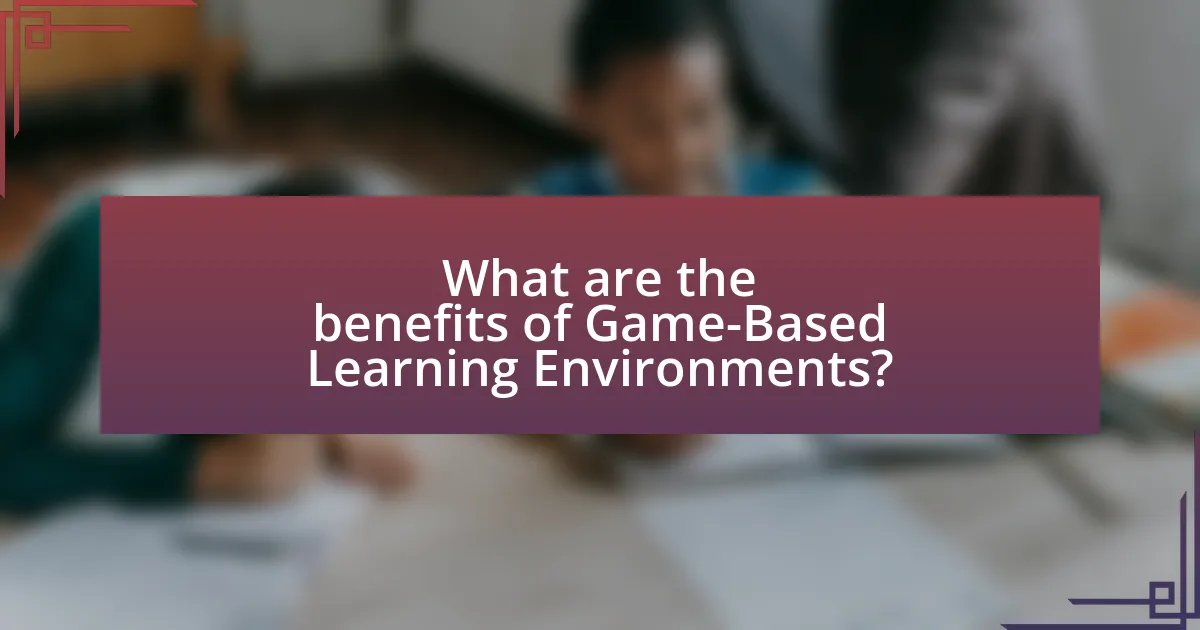
What are the benefits of Game-Based Learning Environments?
Game-Based Learning Environments enhance engagement, motivation, and retention of knowledge among learners. These environments leverage interactive gameplay to create immersive experiences that promote active participation. Research indicates that students in game-based settings demonstrate improved problem-solving skills and critical thinking abilities, as evidenced by a study published in the Journal of Educational Psychology, which found that game-based learning can lead to a 20% increase in knowledge retention compared to traditional methods. Additionally, game-based learning fosters collaboration and communication skills, as players often work in teams to achieve objectives, further enriching the educational experience.
How do Game-Based Learning Environments improve student engagement?
Game-Based Learning Environments improve student engagement by providing interactive and immersive experiences that motivate learners to participate actively. These environments often incorporate elements such as challenges, rewards, and immediate feedback, which enhance motivation and sustain interest. Research indicates that students in game-based settings demonstrate higher levels of engagement, as evidenced by a study published in the Journal of Educational Psychology, which found that game-based learning can increase student motivation by up to 50% compared to traditional methods. This increased engagement is attributed to the game’s ability to create a sense of achievement and foster collaboration among peers, making learning more enjoyable and effective.
What impact does Game-Based Learning have on knowledge retention?
Game-Based Learning significantly enhances knowledge retention by engaging learners through interactive and immersive experiences. Research indicates that learners who participate in game-based activities demonstrate improved recall and understanding of information compared to traditional learning methods. For instance, a study published in the Journal of Educational Psychology found that students who engaged in game-based learning retained 20% more information over a month than those who learned through conventional lectures. This increased retention is attributed to the motivational aspects of games, which promote active participation and emotional involvement, leading to deeper cognitive processing of the material.
How can Game-Based Learning foster collaboration among students?
Game-Based Learning fosters collaboration among students by creating interactive environments that require teamwork to achieve common goals. In these settings, students engage in problem-solving tasks that necessitate communication, negotiation, and shared decision-making, which enhances their collaborative skills. Research indicates that collaborative game-based activities can lead to improved social interactions and a sense of community among participants, as evidenced by a study published in the Journal of Educational Psychology, which found that students who participated in collaborative gaming reported higher levels of engagement and satisfaction in their learning experiences.
What are the potential drawbacks of Game-Based Learning Environments?
Game-Based Learning Environments can lead to several potential drawbacks, including the risk of distraction, unequal access to technology, and varying levels of engagement among learners. Distraction occurs when students focus more on gameplay than on educational content, which can hinder learning outcomes. Unequal access to technology can create disparities in learning opportunities, as not all students may have the same access to devices or high-speed internet. Additionally, varying levels of engagement can result in some students benefiting more from the experience than others, potentially widening achievement gaps. These drawbacks highlight the need for careful design and implementation of Game-Based Learning Environments to ensure equitable and effective educational experiences.
What misconceptions exist about Game-Based Learning?
Misconceptions about Game-Based Learning include the belief that it is merely a form of entertainment rather than a serious educational tool. This view undermines the effectiveness of game-based learning, which has been shown to enhance engagement and improve learning outcomes. Research indicates that game-based learning can lead to higher retention rates and better problem-solving skills, as evidenced by a study published in the Journal of Educational Psychology, which found that students who engaged in game-based learning scored significantly higher on assessments compared to those who did not. Another misconception is that game-based learning is only suitable for younger audiences; however, studies demonstrate its applicability across various age groups and educational contexts, making it a versatile approach to learning.
How can educators mitigate the risks associated with Game-Based Learning?
Educators can mitigate the risks associated with Game-Based Learning by implementing structured guidelines and monitoring student engagement. Establishing clear learning objectives ensures that games align with educational goals, while regular assessments can track student progress and identify potential issues. Research indicates that structured game environments, such as those outlined in the study “Game-Based Learning: A Review of the Evidence” by Hamari et al. (2016), show improved learning outcomes when risks are managed effectively. Additionally, providing training for educators on game selection and integration can further reduce risks, ensuring that games are appropriate and beneficial for the learning context.
What best practices should educators follow when designing Game-Based Learning Environments?
Educators should prioritize alignment between game mechanics and learning objectives when designing Game-Based Learning Environments. This ensures that gameplay directly supports educational goals, enhancing engagement and knowledge retention. Research indicates that games designed with clear educational outcomes lead to improved student performance; for instance, a study by Hamari et al. (2016) found that gamification positively affects motivation and learning outcomes. Additionally, incorporating feedback mechanisms within the game allows learners to understand their progress and areas for improvement, which is crucial for effective learning. Furthermore, fostering collaboration through multiplayer elements can enhance social learning, as evidenced by studies showing that peer interaction boosts problem-solving skills. Lastly, ensuring accessibility and inclusivity in game design accommodates diverse learning needs, making the environment effective for all students.
How can educators ensure inclusivity in Game-Based Learning?
Educators can ensure inclusivity in Game-Based Learning by designing games that accommodate diverse learning styles and abilities. This can be achieved by incorporating adjustable difficulty levels, providing multiple modes of engagement, and ensuring accessibility features such as text-to-speech and color contrast options. Research indicates that inclusive game design not only enhances participation but also improves learning outcomes for all students, as evidenced by a study published in the Journal of Educational Technology & Society, which found that games designed with inclusivity in mind led to higher engagement and achievement rates among diverse student populations.
What tips can enhance the effectiveness of Game-Based Learning experiences?
To enhance the effectiveness of Game-Based Learning experiences, educators should ensure alignment between game objectives and learning outcomes. This alignment facilitates a clear understanding of how gameplay contributes to educational goals, which has been shown to improve student engagement and retention. Additionally, incorporating feedback mechanisms within the game allows learners to understand their progress and areas for improvement, thereby reinforcing learning. Research indicates that games with immediate feedback can increase motivation and learning efficacy, as highlighted in studies by Hamari et al. (2016) in “Gamification: Definitions, Benefits, and Challenges.” Furthermore, fostering collaboration through multiplayer elements can enhance social interaction and teamwork skills, which are essential for real-world applications.
